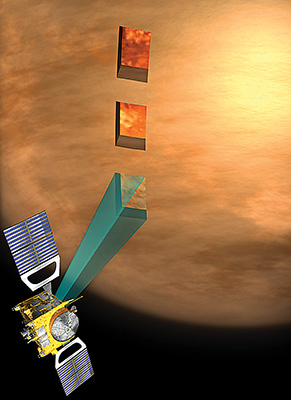
by Carolyn Gramling Thursday, January 5, 2012

Using infrared 'windows' in Venus' atmosphere - narrow bands in the atmospheric spectrum - the Venus Express spacecraft can see through the planet's thick cloud cover to study the land surface. ESA-AOES Medialab
Today, the surface of Venus is a hellhole, seared by scorching temperatures, crushing pressures and a toxic atmosphere of carbon dioxide with occasional clouds of sulfuric acid. But evidence is mounting that billions of years ago, Earth’s evil twin planet was a much more pleasant place — a second blue marble covered by water. The latest data come from the European Space Agency’s Venus Express spacecraft, which has spent three years constructing a detailed map of the surface of the planet’s southern hemisphere and finding new evidence for Earth-like plate tectonics and a watery past.
Scientists have long been curious about Venus’ terrain, particularly its highlands and lowlands. The valleys seem to consist of basalt, based on information sent back by early Soviet spacecraft that successfully landed on the surface in the 1970s (but were crushed in less than an hour by the intense pressure). The highlands, meanwhile, seem to consist of a different type of rock, possibly granite, according to data from NASA’s Galileo mission, which briefly passed by Venus in 1990 and snapped a few images of the equatorial region with its Near-Infrared Mapping Spectrometer (NIMS) instrument.
Such plateaus of granite would point to crustal differentiation, which in turn means both tectonics and water were present at one time, says Nils Müller, a planetary scientist with the University of Münster and DLR Berlin in Germany. To date, granite is only known to exist on Earth; it forms when water-rich crust subducted into the mantle differentiates chemically to form the lower-density minerals that make up the continental crust.
Now the Venus Express, launched in 2005, provides further evidence that Venus is home to granite. Since 2006, the spacecraft has had its eyes trained on the planet’s southern hemisphere, using an instrument called the Visible and Infrared Thermal Imaging Spectrometer (VIRTIS) to pierce through the thick clouds to study the land surface below.
VIRTIS’ images, taken at night, are of thermal emissions from the superhot planet. “Due to the high temperature of the surface, it is nearly glowing in the dark,” says Müller, who led the VIRTIS mapping study. The glow, he says, illuminates the clouds from below, and some light seeps through to the top of the atmosphere, where the orbiter can image it.
From the three years of data collected by Venus Express’ VIRTIS, Müller and his team compiled a detailed map of the heat emissions from the surface of the southern hemisphere of the planet. The highlands, they found, radiated less heat than the lowlands — which fits the hypothesis that the highlands are granite because granite is largely composed of silica minerals, which have lower emissivity than iron-rich basalt.
“It’s really exciting,” says Kevin Baines, a planetary scientist at NASA’s Jet Propulsion Laboratory in Pasadena, Calif., who was an author on the Galileo NIMS study. Both the Galileo mission’s data, which were from near the equator, and the new data seem to point to granite. “More than one spot seems to be showing this now.”
Granite in multiple locations on the planet’s surface, Baines says, also suggests that at one time, the planet may have had large oceans — like Earth. “There might have been a time when, for a billion or two billion years after they were born, both planets were oases, two blue marbles,” he says. “One went awry and the other didn’t.”
Scientists are eager to understand why Venus became so inhospitable, and reconstructing its gentler past is a big piece of that puzzle, Baines adds. One idea for why the fate of the two planets diverged has to do with Venus’ near-lack of a magnetic field. Without that shield, Venus' atmosphere is vulnerable to the sun: Its hydrogen, one of the ingredients for water, has long since been stripped away by the solar wind, and the planet is now bone-dry. Water is necessary for plate tectonics too; without it, the crust may be too rigid for subduction or faulting.
Why Venus has no magnetic field could be a matter of luck, Baines says: Venus’ rotation is agonizingly slow (one Venus day lasts about 243 Earth days), which would prevent it from forming an Earth-like geodynamo generated by the circulation of Earth’s liquid-metal core.
Although the map provides the strongest evidence yet for granite, Müller says, VIRTIS is limited by distance. The few infrared wavelengths that can pierce the cloud cover and measure the properties of the surface are not enough to uniquely identify minerals. The only way to really know what Venus’ highlands consist of, he adds, will be to send a lander to collect samples. But it may be decades before scientists design a lander that can withstand the planet’s forbidding conditions.
© 2008-2021. All rights reserved. Any copying, redistribution or retransmission of any of the contents of this service without the expressed written permission of the American Geosciences Institute is expressly prohibited. Click here for all copyright requests.